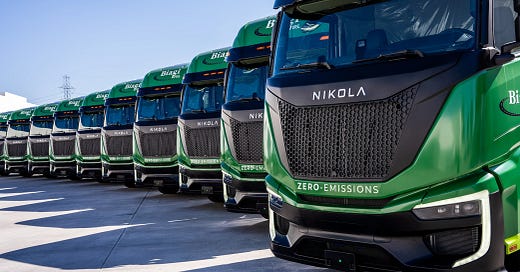“Another green-energy unicorn died this week—Nikola”, By Doug Sheridan
“Its spectacular market crash is another warning about the perils of industrial policy and chasing government subsidies.”
The WSJ Editorial Board writes, another green-energy unicorn died this week Nikola, the electric-truck startup, filed for Ch 11 bankruptcy. Its spectacular market crash is another warning about the perils of industrial policy and chasing government subsidies.
The 11-year-old EV maker aspired to be the Tesla of trucks. Nikola went public in June 2020 through a blank-check merger amid the euphoric pandemic stock-market recovery and politicians’ promises of a Green New Deal. It fetched a $27B market valuation that at the time was greater than Ford’s even though Nikola had sold no vehicles. Supposedly sophisticated investors were taken in by its marketing hype. General Motors announced in 2020 that it was taking an 11% stake in Nikola, hailing it as an “industry leading disrupter.” It proved was disruptive in a different way.
In Jan 2018 Nikola posted a video of its model truck appearing to power effortlessly down a flat road with the caption, “The Nikola Hydrogen Electric trucks will take on any semi-truck and outperform them in every category… weight, acceleration, stopping, safety and features—all with 500-1,000 mile range!” That would be a revolutionary—if true.
It wasn’t. According to a 2021 federal fraud indictment of founder Trevor Milton, an inoperable prototype was towed to the top of a hill. Then Nikola employees released the brakes so it looked like it was cruising along. All the while the door was taped shut to keep it from falling off, and its batteries were removed to prevent the truck from catching fire.
After taking investors for a ride, Milton was convicted in 2022. The marketing deceptions and problems spooked investors. Nikola in 2023 recalled 209 battery-electric trucks owing to fires. As of Oct, it had sold fewer than 500 trucks—and at a heavy loss. Nikola reportedly had sold hydrogen trucks for $351,000—about half what it cost to produce them, though its sales price was still about twice as much as an internal-combustion-engine semi.
California regulators and the Biden Admin tried to boost the electric-truck market with mandates and subsidies. But the gov’t still can’t induce truckers to buy them. High costs and technological limitations make EVs impractical for long-distance trucking operations.
Another electric-truck maker, Lordstown Motors, filed for bankruptcy in 2023. Fisker failed last June. The British electric-bus startup Arrival sold its assets to another EV startup, Canoo Inc, which filed for bankruptcy last month. Even so, the Biden Energy Dep’t provided a $6B rescue for Rivian Automotive after it lost $107,043 on each vehicle it sold during the first nine months of last year.
Our Take: When it comes to the energy transition, the number of examples in which critical thinking and realism were thrown out the door—by both markets and execs—are too many to count. Even so, the saga of Nikola stands out as one of the most inane. Good riddance, we say.






Electric trucks were never going to be viable on long-distance freight routes. Every pound of battery is one pound less payload. Yes the ICE truck has a heavier engine and gearbox and starts its route with half a ton of diesel, but even so the weight penalty made for bad economics. I can see electric trucks succeeding on intra-city routes with loads of about five tons.
Thx for posting. We can wish the energy transition to happen. Without subsidies, many clean technologies are not viable solutions.